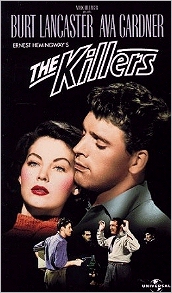 |
The KillersUniversal |
|---|
 |
The KillersUniversal |
|---|
|
Burt Lancaster - Swede Andersen Ava Gardner - Kitty Collins Edmond O'Brien - Jim Reardon Albert Dekker - Big Jim Colfax Sam Levene - Lt. Sam Lubinsky William Conrad - Max, a killer |
Robert Siodmak - Director Mark Hellinger - Producer Anthony Veiller - Screenwriter Elwood Bredell - Cinematographer Miklós Rózsa - Film Score Ernest Hemingway - Original Story |
The complex structure and intense visual stylization of The Killers means that it is usually cited as a classic example of film noir. In fact, the doomed romance between Burt Lancaster and his femme fatale Ava Gardner never really achieves the necessary obsessive quality usually associated with the genre. The film works better when seen as a classic crime movie. Of particular note are the opening, with its sinister cryptic banter between William Conrad and Charles McGraw, and a later robbery scene, with the whole crime executed in a single take. The contributions of Mark Hellinger, whose production debut this was (although he had scripted among other, The Roaring Twenties, 1939), and Robert Siodmak and composer Miklós Rózsa (whose main theme was later borrowed for the opening sequence of TV's Dragnet) have often been praised, but cinematographer Woody Brendell remains a largely unsung hero, surprising given his striking work here.
The film uses Ernest Hemingway's famous short story "The Killers" as the starting point for a complex, flashback-ridden script, in which Jim Riordan (Edmond O'Brien), an insurance investigator, delves into the past in order to discover why Swede Anderson (Lancaster) allows two hired killers, Al (McGraw) and Max (Conrad), to murder him, while making no attempt to evade his fate. O'Brien learns how Lancaster, a boxer, became involved with a gang led by Big Jim Colfax (Albert Dekker) and with Colfax's woman Kitty Collins (Gardner). Lancaster, in his first film role, is used by Dekker and Gardner as a double-cross worked on the gang and it was Lancaster's betrayal by Gardner which effectively killed him long before he actually died. The film earned four Academy Award nominations, including best director and best screenplay.
--PHIL HARDY, from The Gangster
Film Encyclopedia, 2001.A representative example of the complex treatment of time in film noir, and of the pressure the past exerts on the present, is The Killers (1946). The film is an intelligent expansion of Hemingway's short story about a man who passively submits to his own death when two hired gunmen, like evil emissaries from his shrouded past, hunt him down in a small-town rooming house. Although Hemingway offers no explanation for the character's almost indifferent embrace of death, the film attempts to unravel the intriguing mystery of his submission.
The search into the dead character's past is conducted by a dogged insurance investigator whose only clue is an insurance policy that the murder victim left to a cleaning woman in an Atlantic City motel. The investigator learns that Swede Anderson left the woman the policy because she prevented him from killing himself after his girlfriend walked out on him. From this single biographical detail, the claims man begins to penetrate the character's history. From a series of fragmentary interviews, he discovers that Swede was a boxer who fell in with a gang and then took the rap for a woman. After serving his jail sentence, Swede returned to his old cronies at the time they were planning a big payroll heist.
But his old girlfriend Kitty Collins causes trouble for Swede once again, setting him up as the decoy in a double double-cross. Kitty runs off with the money, making it appear that it was Swede who swindled them all. Shattered by her duplicity, Swede retreats from his criminal life, hiding out in a small town where he works at a gas station, lives in a dim furnished room, and eats every night at the same diner (where the film opens as Swede's executioners, hired by the gang boss, await his arrival).
The film's splintered chronology, the flashbacks presented from multiple points of view, and the flashbacks within flashbacks, all have a crucial impact on both the mood and the meaning of the story. As the insurance man uncovers bits and pieces of Swede's background, he constructs different explanations for the character's self-sacrificial death, though only at the end of his search does he light upon the full truth. Till that point, his view of the character is fragmentary and clouded. Swede is one of the most elusive of noir's anti-heroes, Kitty is one of the genre's most masked spider women; and the film's own devious structure, its conflicting points of view, its choppy handling of time, reinforce the enigmatic aura that enshrouds the two main characters.
--FOSTER HIRSCH, from Film Noir
The Dark Side of the Screen.
A selection of The Killers related films.
|
Find The Killers on eBay.com
A selection of The Killers books.
|
|
home: The Noir 'net |
back to: CLASSIC NOIR |
|
Any comments, additions or suggestions
should be adressed to: The Noir 'net / Eric B. Olsen / ericbolsen@juno.com |
Other Web Sites:
History of Horror Hard Bop Homepage The War Film Web Author Eric B. Olsen |